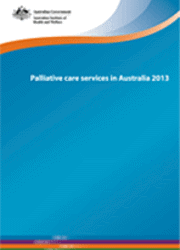Summary
This report on Australian palliative care services is the second in this series. It provides detailed information on the national response to the palliative care needs of Australians using a range of Australian Institute of Health and Welfare (AIHW) and other national data sources.
Service provision
There were 54,466 palliative care-related separations from public and private hospitals in Australia in 2010-11, with patients aged 75 years and over accounting for nearly half (49.5%) of these. There was a 49% increase in palliative care-related separations between 2001-02 and 2010-11.
In 2010-11, palliative care separations accounted for 0.6% of all separations, but 37.2% of patients who died as an admitted patient had been a palliative care patient during their final separation. Approximately 16,500 palliative care patients died with cancer as a principal diagnosis.
There were just over 221,000 permanent residential aged care residents in 2011-12 with completed Aged Care Funding Instrument (ACFI) assessments; almost 1 in 20 of these residents had an ACFI assessment indicating the need for palliative care during this reporting period.
Resources and outcomes
Nationally, about 9,600 patients received a palliative medicine specialist service subsidised through the Medicare Benefits Schedule (MBS) during 2011-12 for which approximately $3.5 million was paid in benefits. Over the 5 years to 2011-12 benefits paid for all palliative medicine specialist services has more than doubled.
Nationally, more than 19,000 patients had a palliative care-related prescription subsidised through the Pharmaceutical Benefits Scheme (PBS) during 2011-12, which equates to a rate of 85.8 patients per 100,000 population. The medication type laxatives were the most frequently dispensed palliative care-related prescriptions in 2011-12, followed by analgesics and anti-epileptics (37.3%, 22.2% and 14.5%, respectively).
Specialist palliative medicine physicians made up nearly 4 in every 1,000 (0.38%) employed medical specialists in Australia, with an estimated 92 working in Australia in 2011. In 2011, more than half (56.6%) of employed specialist palliative medicine physicians were female.
This was more than double the proportion of all employed female medical practitioners who practice other clinical specialities (25.6%).
There were 108 specialist palliative care services that reported to the Palliative Care Outcomes Collaboration in 2012-an increase of 1 service since 2011. More than 30,400 patients accessed specialist palliative care services in 2012, an increase of 11.8% from 2011 (27,201). Just over one-third (36.0%) of services met benchmark 3.2, where 60% of patients in moderate/severe pain at phase start were reduced to absent/mild pain at phase end.



